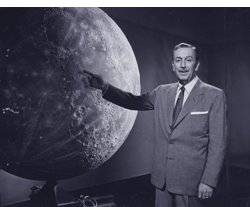
It's the 40th Anniversary of the Man on the Moon and during the next three days Disney and more will do a special tribute to this memorable event. As this is a Disney fan site, we will have a look to the different Disney productions or attractions themed on the "space" theme.

Today the first article is all about the great TV series aired in the 50's "Man and the Moon" and "Mars and beyond". These series were done with the help of future NASA scientists and Walt, always visionary, asked Wernher Von Braun - who will designed later the Saturn 5 rocket for the Apollo missions - what could be his vision of the future space travels. It's also thanks to the series that President Ike Eisenhower after a private screening became more interested in the conquest of space, and then launched the space program...which finally will send a man on the moon!

What is less known is that genius movie director Stanley Kubrick took a lot of inspiration out of these series when he did ten years later his legendary "2001, A Space Odyssey" movie. Kubrick even paid a tribute to Disney animator Ward Kimball Director of the TV series. In the second part of "2001" some astronauts are sleeping "frozen" in a kind of sarcophagus during the long trip of the spaceship Discovery. And the name of one of them - written on the cryogenic coffin - is "Kimball", a tribute of Kubrick to Ward Kimball.

To come back to the TV series, Man and the Moon begin with a humorous look with Man's fascination with the Moon through animation. This segment features the Moon's usage in everything from William Shakespeare and children's nursery rhymes to lunar superstitions and scientific research. Then Ward Kimball comes on with some information on the moon, supplemented by graphics. Kimball then introduces Wernher Von Braun, who discusses plans for a trip around the moon. Finally, a live action simulation from inside and outside the manned Lunar Reconn Ship RM-1 dramatizes what such an expedition might be like, including an almost-disastrous hit by a very small meteor.
Here is some artwork from the "Man in Space" animated series.


Wernher Von Braun - the creator of the Apollo rockets - employed as technical consultant, is here with Walt. Von Braun is the first on the left on the picture below.

Von Braun - who was a man who knew what the word rocket means as he worked on the german V2 project during world war 2 - helped to design some of the amazing spaceship that you will see on the videos below.

Here is Walt and Wernher Von Braun again with models used for the show.

Ward Kimball, Disney's famous animator and WED imagineer is here with Walt and one of the model of the spaceship to Mars.


Thanks to the Youtube links below you'll be able to see the whole show, and here is the first one "Man and the Moon".
Two years later, "Mars and beyond" was aired on December 4, 1957. Always directed by Ward Kimball and narrated by Paul Frees. This new episode discusses the possibility of life on other planets, especially Mars. It begins with an introduction of Walt Disney and his robot friend Garco, who provide a brief overview. It continues with an animated presentation about mankind seeking to understand the world in which he lives, first noticing patterns in the stars, and developing certain beliefs regarding the celestial bodies. Theories from scientists and philosophers are discussed, including Ptolemy's inaccurate, but formerly-accepted theories, as well as those of Copernicus. Life on other planets is considered, soon focusing on Mars. Ideas from science-fiction authors H.G. Wells and Edgar Rice Burroughs are brought to life with more colorful animation. Pulp science fiction comics of the time are parodied in the same straightforward tone as everything else (this segment features Kimball's comic tone and there's even a cameo appearance by Donald Duck).

After this, the program adopts a serious tone as it profiles each of the planets in the solar system, from the perspective of what would happen to a man on them. The program claims that whereas most of the planets are either too cold or too hot for life as we know it, life on Mars could almost be normal, something that is of increasing importance for the future. Dr. E.C. Slipher then discusses the Red Planet and the possibility that life is already there. More animation speculates what the conditions on Mars might be like. This section is filled with striking, inventive and decidedly atypical Disney animation.

Above: Animator Julius Svendsen with Ward Kimball and models designed for the show.
Below: Wernher Von Braun, technical consultant on the series, with the same model.

The program wraps up with what a trip to Mars would entail for a space crew and its vessels. Contributor/spacecraft designer Ernst Stuhlinger - on the picture below with Von Braun holding a model used for the show - presents his design and details regarding a unique umbrella-shaped MarsShip: The top portion would be a revolving outer quarters ring providing artificial gravity for the crew of 20, under 'parasol' coolant tubes. At the other end would be a sodium-potassium reactor to provide power to the midsection electric/ion drive. Attached upright would be a chemically-fueled winged tail-lander. The mission shown involves six MarsShips, ultimately reaching 100,000 mph, taking a 400 day, spiral course to Mars. There, they would spend 412 days on the surface before returning.

I will end this article with the full "Mars and beyond" episode. If you don't have a lot of time, jump to the last two parts, the most interesting one.
Thanks to leave a comment or discuss this interview on D&M english forum on Mice Chat
Photos and videos: copyright Disney
You can find the complete series of the three Man in space 1950's tv shows which includes "Man in Space" , "Man and the Moon" and "Mars and Beyond" on the Disney treasures dvd set "Tomorrowland" at amazon.com.



Ward Kimball's space shows are truly some of the best Disney TV programs ever made.
ReplyDeleteThanks for pulling all the great material together for this post, Alain! I really enjoyed it